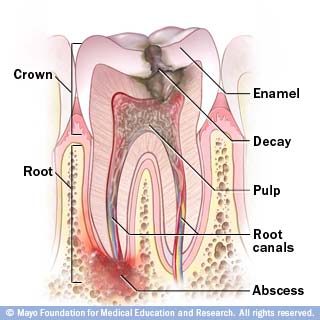Root canals are not the scourge of dentistry like they used to be. By using good local anesthesia techniques, a root canal can be performed with little to no discomfort. A root canal is done by first placing an opening into the pulp chamber.
This is a hollow area in the center of the tooth where the dental pulp (a collection of nerves and blood vessels) resides. Once access to the pulp chamber has been obtained, the dentist will clean out any debris, whether it is live nerve tissue or dead, necrotic material. At this point, the actual root canal(s) are located. These are tiny channels that go through the root and exit at the end to communicate with the bone. Sometimes these canals can be very torturous to negotiate and many times requires a dentist with many years of experience to successfully complete the process. The canals are meticulously cleaned by a series of “files”, pin-like instruments. With each successive file, it will clean the walls of the canal, then the debris is flushed out with a sodium hypochlorite irrigating solution.
The canals are then dried and filled with a sealer and an inert material called gutta percha. The root canal has now been completed, hopefully without pain, and is ready for restoration.







